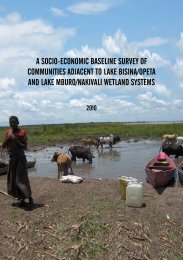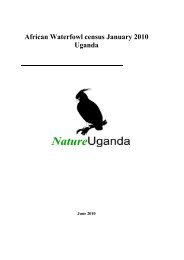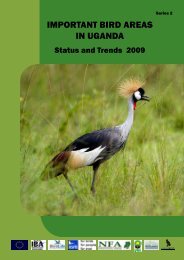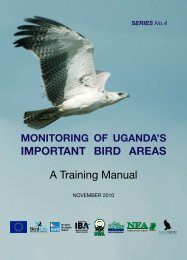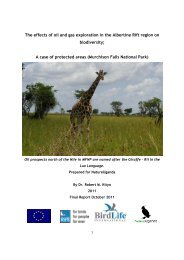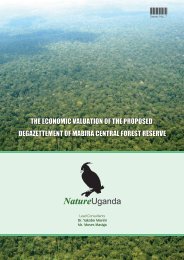A Ecological Baseline Surveys Of: - Lake Bisina - Nature Uganda
A Ecological Baseline Surveys Of: - Lake Bisina - Nature Uganda
A Ecological Baseline Surveys Of: - Lake Bisina - Nature Uganda
You also want an ePaper? Increase the reach of your titles
YUMPU automatically turns print PDFs into web optimized ePapers that Google loves.
4.2 Rapid plant survey of <strong>Lake</strong> <strong>Bisina</strong>-Opeta wetland sysyems<br />
4.2.1 Introduction<br />
<strong>Lake</strong> <strong>Bisina</strong>-Opeta wetland system is located in North-Eastern <strong>Uganda</strong> in the Teso and Karamoja<br />
regions. The <strong>Bisina</strong> wetland system lies in the Eastern end of the <strong>Lake</strong> Kyoga basin and it covers<br />
an area of 54,229 ha while the Opeta wetland covers an area of 68,913 ha. <strong>Lake</strong> <strong>Bisina</strong> is a shallow<br />
freshwater lake, 32 km long and 6 km wide surrounded by a papyrus swamp. Historically, the<br />
system has been valuable for flood prevention. However this function is becoming less effective<br />
with growing settlement on marginal lands and silting within <strong>Bisina</strong> and the neighbouring Opeta<br />
wetlands caused by degradation of the Mount Elgon water catchment.<br />
The <strong>Lake</strong> <strong>Bisina</strong>-Opeta wetland system lies between 33°51’- 34° E and 01°35’ - 01°’N, at an elevation<br />
of 1,050 m a.s.l. in the Eastern end of the <strong>Lake</strong> Kyoga basin. The dominant open water species<br />
for both lakes are Nymphea nouchali, Najas pectinata and Ceratophyllum dumersum. The marshy<br />
margins are fringed by a leafless sedge Cyperus articulatus and Echinochloa pyramidalis, which<br />
dominate parts of the shorelines. In the deeper waters off the shore, the vegetation is dominated by<br />
Vossia cuspidata and some patches with Cyperus papyrus. The main vegetation type of this area<br />
is Acacia - Hyparrhenia - Themeda grass savannah (Langdale-Brown 1964).Plants offer potential<br />
advantages over other taxa as biodiversity indicators because they are the primary producers. Their<br />
abundance and diversity is likely to influence the species richness belonging to higher trophic levels<br />
(Kent et al. 1996). An inventory of all plant species was carried out in the study site.<br />
Fig. 6 Plant survey of <strong>Lake</strong> <strong>Bisina</strong> - Opeta wetland sysyems<br />
4.2.2 Physical and ecological features<br />
This wetland system consists of perennial grasses, sedges, Acacias, thickets of Harissonia<br />
abyssinica in the drier areas, and has been modified by human activities like grazing, fishing and<br />
farming. In terms of land tenure and status, the sites are designated Ramsar sites and are Important<br />
Bird Areas.<br />
66<br />
<strong>Ecological</strong> <strong>Baseline</strong> <strong>Surveys</strong> of <strong>Lake</strong> <strong>Bisina</strong>, <strong>Lake</strong> Opeta, <strong>Lake</strong> Mburo and Nakivali Wetlands Systems



